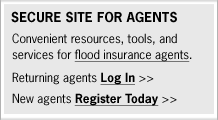
Hurricanes Can Bring Inland Flooding
This Hurricane Season, be FloodSmart about storm effects – wherever you live
Statistics from the National Flood Insurance Program
Hurricane Season 2004
The 2004 Hurricane season was the costliest in our Nation's history. Five hurricanes hit the United States last year, four of which struck Florida in close succession, including Hurricane Charley, the first Category 4 storm to make landfall in the state since Hurricane Andrew in 1992.
States up and down the Eastern United States were affected by the storms either at their full hurricane strength or after they had been downgraded to tropical storms. Many of the tropical storms caused major inland flooding damage along the Appalachian mountain chain.
Inland Flooding: Did you know…
Some of the most damaging floods after a hurricane occur hundreds of miles from the coast. Even though the state of Pennsylvania has no ocean coastline, it repeatedly faced intense rainfall causing dramatic inland flooding during last year's hurricane season. In 2004, hurricane season flood insurance claims for Pennsylvanians were second only to Florida. Residents of that inland state received more than $175 million in total payments.
A tropical storm can produce more rainfall than a Category 5 hurricane. The largest amount of rainfall from hurricanes is usually produced by slow moving tropical storms that stall over an area. As all hurricanes weaken to tropical storms and move inland, the threat of torrential rains and high winds over large areas intensify the risks of flooding.
Inland flooding can occur almost immediately – and even a small amount of flooding can cause significant risk and damage. As tropical storms move inland, rainfall dumped in short timeframes can result in flash flooding that can last up to a week or more. Just six inches of moving water can sweep a person off his or her feet, and only a few inches of water can cause thousands of dollars of damage to homes and businesses.
Be FloodSmart –Inland Flooding Preparedness Tips:
- Monitor any tropical storm systems. Make sure you and your family are aware of storm paths and pay attention to any flood-related advisories or warnings for your community.
- Make sure you have an emergency plan and contact. Plan and practice a flood evacuation route and ask someone out of state to be a "family contact" in case you are separated from loved ones.
- Get flood insurance. Visit www.FloodSmart.gov or call 1-800-427-2419 to learn your risk, prepare for inland flooding, and discover how to purchase a National Flood Insurance Policy. A 30-day wait period means you should act now to protect your property. The toll-free number and Web site provide flood insurance resources and information, including tools to find an agent and estimate the cost of insurance premiums.




500 C Street SW, Washington, D.C. 20472
Disaster Assistance: (800) 621-FEMA, TTY (800) 462-7585
U.S. Department of Homeland Security
FEMA Home | Contact FEMA |
Privacy Policy | Important Notices |
FOIA | USA.gov | DHS
